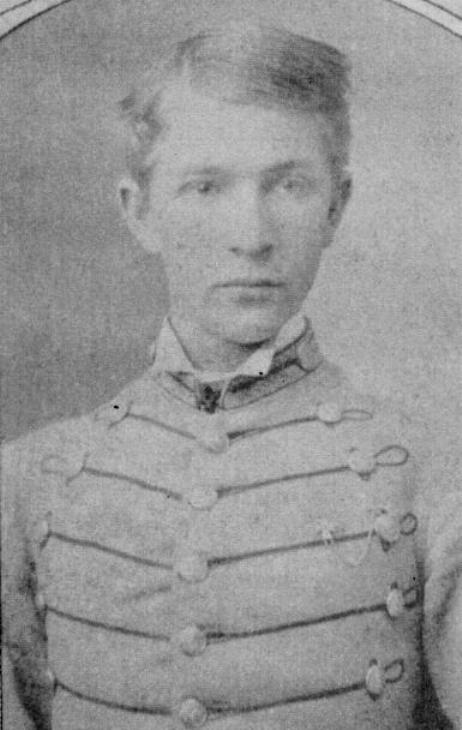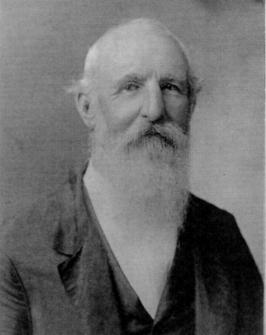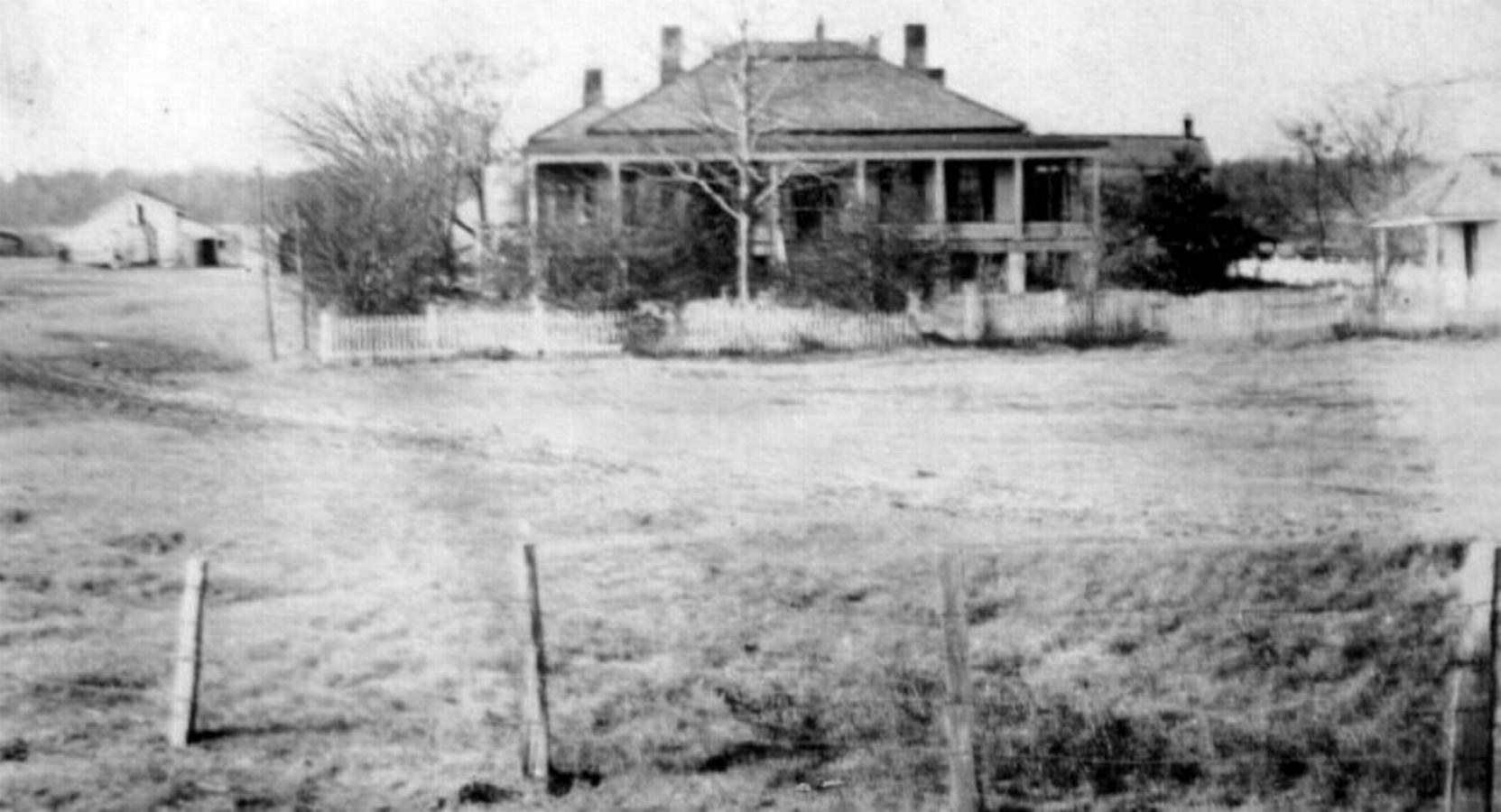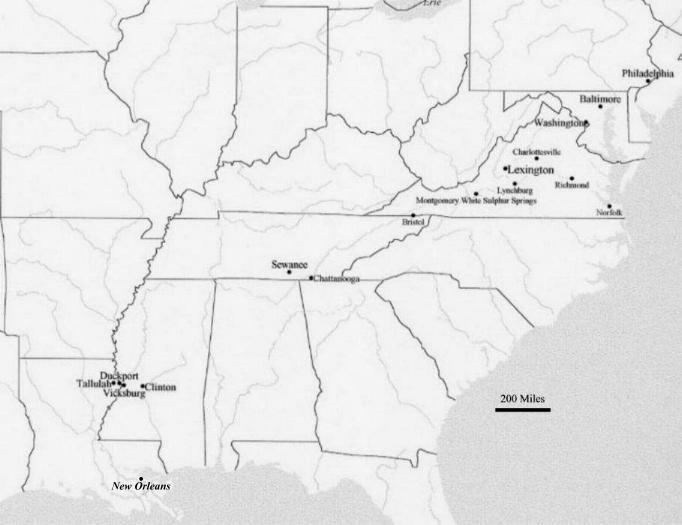THE DIARIES OF RICHARD KINSEY
BONEY
of Duckport Plantation, Madison Parish, Louisiana
Virginia
Military Institute Cadet 1874-1878
University
of Virginia Law School 1879
University of Louisiana
(now Tulane) Law School 1880

V.M.I. Cadet Richard Kinsey Boney -- age 16 – about 1875
Compiled, Edited, Annotated and Illustrated
by Richard P. Sevier
©2000 Richard P. Sevier (dicksevier@gmail.com). This material is intended for informational use only and may not be reproduced by
ANY means whatsoever without written permission from the author
The diaries of Richard K. Boney, my
grandfather, came to light after a February 1984 fire in his former Tallulah,
Louisiana home. In 1985, after being read and photocopied, the diaries were
donated to the Virginia Military Institute along with other Boney V.M.I.
memorabilia. Full credit for the idea of compiling these diaries belongs to my
wife Babs who suggested this in the summer of 2000. As I began to copy the
material I discovered that some portions of the diaries had not been
photocopied correctly in that the writing on some photocopied pages had been
truncated along the bound margin.
Words cannot express the appreciation due to Diane B. Jacobs, V.M.I. Archivist, and her staff without whose help this compilation would not have been possible. These fine folks painstakingly supplied the missing words; photocopied the missing pages and supplied many of the photos used herein. They also supplied the V.M.I. school directory information on which many of the footnotes are based. Additional thanks are due to the Archive Section of the University of Virginia, who supplied an 1880 UVA directory and to my sisters, Dorothy Sevier Elliott of El Dorado, Arkansas and Sherrill Sevier Pirone of Lexington, Kentucky, who supplied other copies of the diaries, photos and additional Boney memorabilia. Credit should also be given to Bob Conte, Historian of The Greenbrier Hotel in White Sulphur Springs, West Virginia, for supplying data on the “Sulphur spring” resorts of Virginia and to Dorothy H. Bodell, author of Montgomery White Sulphur Springs – A history of the resort, hospital, cemeteries, markers, and monument. This data was extremely helpful in understanding the significance of these old post Civil War resorts. Thanks also to Steve Schenkenberg, Editor, The Magazine of Sigma Chi / Sigma Chi Online, for Sigma Chi historical data. Photo and newspaper credits may be found in the List of Illustrations and other Credits. A Bibliography is also included.
Richard Kinsey Boney began his V.M.I.[1] diary in October 1874, about a month after he entered the Institute as a fourth class (freshman) “rat”. He was only fifteen years old at the time but had already completed at least one semester at Mississippi College at Clinton (established 1828) – the oldest college in Mississippi. He also had already joined Sigma Chi Fraternity at that early age.
The diary is presented here exactly as it was written, with no attempt to correct the spelling, grammar or punctuation – all of which were inconsistent, to say the least. Anything added that was not in his original handwriting and any explanations added are in italics unless they are direct quotes or from other articles. The spelling of some names was corrected after the correct spelling was learned. It should be noted that he apparently studied no English Grammar or Composition at V.M.I., and if he had any at all it must been during his short stay at Mississippi College. According to Ms. Diane B. Jacob[2], Archivist at V.M.I.’s Preston Library:
“The
VMI curriculum was based from the beginning on sciences, engineering, and math,
in addition to the liberal arts; the curriculum was very innovative in the19th
century and stood in contrast to the classical education still offered at most
universities. General Smith[3]
believed in the value of a "scientific education" that would enable graduates
to make practical contributions to the state and country.”
Three volumes of the V.M.I. diaries were made (in addition to one each at the University of Virginia Law School in 1879 and the University of Louisiana (now Tulane) Law School in 1880. The diaries were written first in pencil; then copied to another book in ink. They are by no means exact replicas[4] and sometimes one copy has more detail than the other. These diaries were handwritten in notebooks with a very cultured, flowing script and, in most cases, were easy to read. Unfortunately, the diaries were subject to water and fire damage during a 1984 Tallulah fire that caused some of the pages to be lost and some of the text to be undecipherable.

Example of Richard K. Boney’s Volume I (ink)
diary
His diary chronicles the activities of a prosperous plantation owner’s homesick son who began by creating resolutions for himself because of the shame he felt for some of his recent actions. At first, Richard Kinsey Boney seems to be an introverted, self-conscious teenager who has never been far from home. He longs for letters from his parents and friends and is unhappy with being at V.M.I. Later, he will become a medal-winner on the debate team, of which he will become president. He will also become socially active with fraternal organizations and countless “young ladies”. His diary displays many southern customs and expressions of the times; discusses various topics of the day and communicates his devotion to his fraternity – Sigma Chi. At one point during his last year at V.M.I. he was selected by the Vicksburg Herald to write a column about his activities. The diary should be of special interest to anyone who has attended (or intends to attend) military or law school and to scholars of the Reconstruction period immediately following the Civil War.
Modern day readers will have a hard time understanding that Richard K. Boney had no electricity; so he read by gaslight or by candle, if gaslight was not available. He had no radio or television; so any news he received came from letters or newspapers or hear-say, which were all well “after the fact.” There were no automobiles or airplanes; so travel had to be by packet boat, stagecoach, steamer, railroad, buggy, carriage, horse or by walking. There were no telephones; so when he “called on” his young lady friends, he had to walk to their homes or hire a buggy (hack) or horse, not knowing whether or not the ladies would be there. Of course he had no running water or plumbing facilities, as we know them today.
Richard Kinsey Boney[5] was born on Culverson Plantation, Madison Parish, Louisiana, October 19, 1858 – the eldest child of Greene Livingston Boney (1829-1910) and Martha Cocke Boney (1830-1895). At the time of his birth his father was manager of the plantation.

Col. Greene L. Boney
By the time of the Civil War Greene L. Boney had accumulated considerable property and owned a number of slaves. When the war broke out he sent his family to his former home in eastern Mississippi and entered the army in Company K, of Abbey’s battery of the First Mississippi artillery. Richard K. Boney was only about 5 years old at this time. Greene L. Boney served until the close of the war. He was in the Battle of Plain’s Store and the Siege of Port Hudson, LA where he was captured, escaped and was recaptured at Blakely where he was taken prisoner and sent to Ship Island. There he was kept prisoner until the close of the war. At some point he was wounded by a spent minié ball.
After the war Greene
L. Boney, having lost nearly everything, returned to Madison Parish to manage a
plantation and ultimately resume his position as a prosperous Madison Parish
planter. By January 1870 he had purchased Duckport Plantation and owned several
other plantations (including Culverson) in the
vicinity, together with several thousand acres on Big Black Island in Tensas
Parish.[6] By
1881, in addition to the Big Black Island property, he owned almost 4,000[7]
acres in Madison Parish – all rich, alluvial lands along the Mississippi River.
Greene L. Boney very
much admired Jefferson Davis, and the Boney home at Duckport, built of cypress
timber cut on the plantation, was a copy of Davis’ home “Beauvoir” on the
Mississippi coast near Biloxi. Since the Mississippi River was only a few
hundred yards away, the Boney home was built seven feet off the ground to
protect it from annual flooding. It has been said that steamboats on the River
could be seen from the front porch. Unfortunately, the River has now washed
away the home site and most of the land as it eroded its way westward. In fact
the original site of the home is now on the east side of the River.

Boney home at
Duckport in early 1900’s
It was common practice in the
latter nineteenth and early twentieth centuries for
children of plantation owners to be tutored at home, and the Boney home was no
exception. The small building to the right in the photo above was the “school
house.” There were no high schools in Madison Parish at this time.

Beauvoir, Jefferson Davis' Home near Biloxi, MS, after which the Boney home was designed
And so the stage was set in September
1874 for Richard K. Boney, a very religious, frail lad of fifteen, son of a
prosperous planter, to embark upon an 850-mile trip to Lexington, Virginia, to
further his education at a strict, no nonsense school with mostly scientific
and military curricula and extremely Spartan accommodations – Virginia Military
Institute. He apparently did not return to Louisiana until late 1879, although
he did spend each summer with his family, mainly at an Appalachian mountain
resort called the Montgomery White Sulphur Springs in southwestern Virginia. He
will write to his father almost every Sunday and will sequentially number his
father’s letters to him as they arrive. He will attend a variety of churches
practically every Sunday and will record the text from which each sermon was
derived. And he will become a bona fide V.M.I. Cadet – although it will take a
little time. After graduation from V.M.I. in 1878 he will attend the University
of Virginia Law School in 1878-79 and will graduate
from the University of Louisiana (now Tulane) Law School in 1880.

Index map showing relation of Duckport Plantation to Lexington, VA and other points of interest

V.M.I. Campus in 1928.
Very few of these buildings were present during 1874-1878
Note: These diaries have been
presented for web viewing (with the Preface serving as “Home Page”) in seven
Chapters, a Preface and an Epilogue – all of which can be reached by clicking
on the appropriate hyperlinks below or the hyperlink at the
end of each chapter. Each section is annotated with vintage photographs,
drawings and footnotes describing the people mentioned,
where they were from, what they did in later life and when and where they died. Several of the chapters are very large and, because
of the many photos, may take quite a while to download.
For the purposes of web presentation the footnotes are shown in blue or
purple as endnotes and will be found at the end of each chapter. However, they
can be viewed instantly by clicking on them. To return to the previous
position, click on the “Back” arrow or on the footnote number. An alphabetical list
of footnoted individuals is also available showing interesting facts about
the individual and in which chapter the person was first mentioned. In addition
there is a list of
the many young ladies he courted during this time.
List of Illustrations and Other Credits
Alphabetical List
of Footnoted Individuals
List of Young
Ladies
Chapter 1 --
1874 – Virginia Military Institute
Chapter 2 --
1875 – Virginia Military Institute
Chapter 3 --
1876 – Virginia Military Institute
Chapter 4 --
1877 – Virginia Military Institute
Chapter 5 --
1878 – Virginia Military Institute
Chapter 6 --
1879 – University of Virginia Law School
Chapter 7 --
1880 – University of Louisiana (Tulane) Law School
Selected Highlights
Virginia Military Institute 1874 - 1878
Cadet
Kinney incident 10/29/1874
Accidental
shooting of DeBruhl 3/1/1875
Escorting
statue of Robert E. Lee 4/17/1875
Battle
of New Market 5/15/1875
Montgomery
White Sulphur Springs 7/8/1875
Learning
how to dance July 8 1875
Initiating
the “rats” August 14, 1875
Starts
Numbering letters from his father 9/12/1875
Unveiling
statue of Stonewall Jackson in Richmond 10/24/1875
Friends
of Temperance Meeting March 16, 1876
Appendix
Volume I – Money Expended
Appendix
Volume I – Money Loaned
Appendix
Volume I – Money Received
Summer
trip to Centennial at Philadelphia 6/30/1876
Summer
trip to Washington 7/11/1876
Stopover
at Montgomery White Sulphur Springs on way to Sewanee 7/14/1876
Beginning
of summer at Sewanee, TN 7/28/1876
Trip to
Centennial at Philadelphia with corps 10/4/1876
No gas;
had to use candles for light 11/27/1876
Mutiny
because of “no skating” policy 12/4/1876
Loses
Declaimer’s Medal vote 4/21/1877
Brother
James shipped 4/30/1877
Elected
president of dancing club 9/20/1877
Elected
president of Cadet Society 10/13/1877
Death of
Cadet Agar 11/20/1877
Wins of
Orator’s Medal 4/27/1878
Commencement
exercises 7/2/1878
Summer
at Warm Springs 7/7/1878
Back
to Montgomery White Sulphur Springs 7/20/1878
Participates
in “Grand Tournament” 8/8/1878
Selected Highlights
University of Virginia Law School - 1879
Hot Whiskey Punch Remedy 1/17/1879
Abortive Examination 2/27/1879
Trip to Washington & Congress 3/21/1879
More on “Smoking Incident” 5/29/1879
Apologies to Drury & Moore; Aumann & Saulsbury 5/30/1879
Saulsbury Accepts Challenge to Fight 6/1/1879
The Day of the Battle 6/5/1879
Jones Caught Cheating on Examination 6/9/1879
Visit to his Brother at Randolph-Macon College 6/17/1879
Leaving UVA for good, Heading for V.M.I. Ball 6/24/1879
Initiated into “Eli Bananas” 6/27/1879
Leaves V.M.I. for Blue Ridge 7/7/1879
Selected Highlights
University of Louisiana Law School - 1880
First mention of his wife-to-be (16 years later)
Legislature in Session 1/17/1880
General Gibson Elected to U.S. Senate 1/22/1880
Father asks him to return home because of health problems 1/24/1880
Ex-President Grant comes to New Orleans 3/31/1880
Introduction to Artichokes 4/11/1880
City Park a “pasture”? 4/18/1880
Declines his first job offer as “political” 4/20/1880
More on first job offer 4/25/1880
Final Examinations begin 4/28/1880
Results of Examinations Announced 5/3/1880
Commencement Day and Diploma Controversy 5/8/1880
Return
to Duckport 5/10-23/1880
Chapter
1 – Virginia
Military Institute -- 1874


